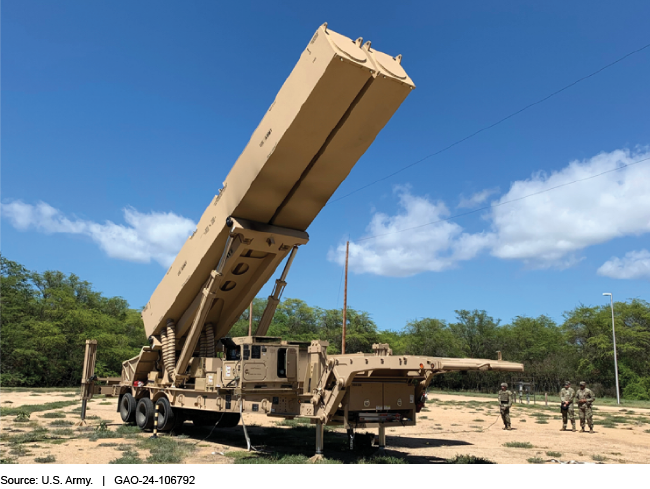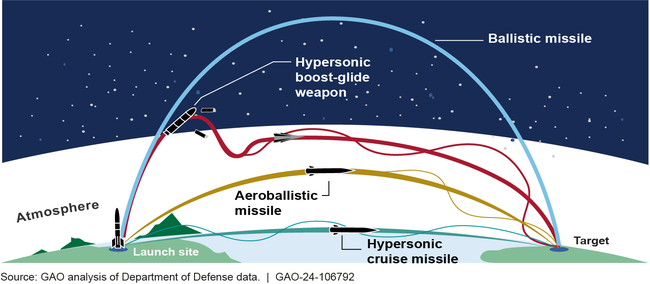Hypersonic Weapons: DOD Could Reduce Cost and Schedule Risks by Following Leading Practices
Fast Facts
The Department of Defense is working to quickly develop hypersonic weapons, which are capable of moving at least 5 times the speed of sound and have unpredictable flight paths that could give the military a tactical advantage.
Most of DOD's efforts to develop hypersonic weapons aren't using modern digital engineering tools, such as virtual representations of physical products. By not following this leading practice, they won't benefit from the tools' advantages, such as speeding up the schedules for prototypes and making it easier to incorporate changes based on user feedback.
We recommended addressing this and applying other leading practices.
A Long-Range Hypersonic Weapon

Highlights
What GAO Found
The Department of Defense (DOD) is increasingly investing in the development of hypersonic weapons. These weapons' unique characteristics—such as the ability to maneuver at very high speeds—could allow the U.S. to strike heavily defended targets from a distance.
Comparison of Ballistic and Hypersonic Missile Trajectories

All six offensive hypersonic weapon efforts GAO identified have placed a high priority on delivering quickly, with all intending to deliver a “minimum viable product”—one with the initial capabilities needed for users to recognize value. Four of the efforts, however, are not soliciting user feedback to determine what capabilities to include in their minimum viable product, a leading practice for product development identified by GAO in July 2023.
In addition, four efforts have not adopted leading practices for using digital engineering tools, another leading practice for product development. These tools include virtual representations of physical products. Employing modern digital engineering tools and directly soliciting user feedback both have the potential to speed up the design process, reduce costs, and develop a more usable product.
While DOD has identified and analyzed cost risks, the cost of these weapons is difficult to estimate. This is in part due to DOD's limited experience developing and fielding hypersonic weapons. For example, the Navy's estimate for Conventional Prompt Strike—among the most mature cost estimates available—compensates for the lack of quality historical data by relying heavily on the views of subject matter experts. Expert views are best used sparingly, as they can be prone to bias, unless estimators analyze and account for that bias. Addressing this and other issues in accordance with GAO leading practices for cost estimates could provide Navy decision-makers a more accurate estimate.
DOD implemented most elements of an effective risk management framework, which allows agencies to assess and monitor threats to achieving their goals. DOD is not, however, comprehensively reporting to Congress about progress against DOD-wide risks to fielding hypersonic systems. Reporting this information at an enterprise level provides a more complete picture of DOD's efforts and progress, while promoting transparency.
Why GAO Did This Study
Offensive hypersonic weapons move at least five times the speed of sound and have unpredictable flight paths. DOD has begun multiple efforts to develop offensive hypersonic weapons that can be launched on the ground, in the air, and at sea. High costs and failed tests are a concern for some of these efforts.
A joint explanatory statement includes a provision for GAO to review DOD's efforts to develop offensive hypersonic weapons. This report addresses the extent to which DOD's hypersonic efforts are: (1) employing leading practices for product development, (2) identifying and analyzing cost risks, and (3) implementing effective enterprise risk management, among other objectives.
GAO reviewed documentation for the six hypersonic efforts currently being developed by the Army, Air Force and Navy, and interviewed DOD officials.
GAO assessed these efforts using its leading practices for product development, cost estimating, and risk management, as appropriate.
Recommendations
GAO is making 10 recommendations to DOD, including increasing the incorporation of feedback from users into system designs, expanding the use of modern digital engineering tools, improving the Conventional Prompt Strike cost estimate, and expanding enterprise-level reporting activities. DOD concurred with these recommendations.
Recommendations for Executive Action
| Agency Affected | Recommendation | Status |
|---|---|---|
| Department of the Navy | The Secretary of the Navy should ensure the Standard Missile 6 (SM-6) Block IB effort solicits and incorporates relevant user feedback throughout development. (Recommendation 1) |
On June 28, 2024, the Department of Defense provided comments in response to this report, concurring with this recommendation. In February 2025, DOD stated that the SM-6 Block IB program regularly solicits user feedback through recurring fora such as the Surface Warfare Requirements Group. The program has also established a Tactics Working Group, which also solicits user feedback to support the development of a concept of operations as well as the eventual integration of the final capability, once available. We have requested more details on this working group, and when we receive more information we will update the status of this recommendation.
|
| Department of the Air Force | The Secretary of the Air Force should ensure the Hypersonic Attack Cruise Missile effort solicits and incorporates relevant user feedback throughout development. (Recommendation 2) |
On June 28, 2024, the Department of Defense provided comments in response to this report, concurring with this recommendation. In February 2025, DOD reported to GAO that the HACM effort has established avenues for soliciting user feedback. These mechanisms include both the organization responsible for HACM's requirements as well as with the intended HACM operators, including aircrew, pilots, and weapon system officers. The program is also working with mission planning subject matter experts to ensure that all test related launches measure the desired weapon effects in real-world launches. GAO is following up to obtain additional support for these actions and will then assess closure of the recommendation.
|
| Department of the Navy | The Secretary of the Navy should ensure the Hypersonic Air-Launched Offensive anti-surface warfare effort solicits and incorporates relevant user feedback throughout development. (Recommendation 3) |
On June 28, 2024, the Department of Defense provided comments in response to this report, concurring with this recommendation. In February 2025, DOD stated that the HALO effort regularly solicits user feedback through a variety of channels, particularly the Naval Aviation Warfighting Development Center, through which the program is able to speak to TOPGUN Naval aviation subject matter experts, as well as those with experience in airborne early warning and naval strike operations. In addition, two key performance parameters on the HALO effort were direct inputs from TOPGUN leaders. GAO is following up to obtain additional support for these actions and will then assess closure of the recommendation.
|
| Department of the Air Force | The Secretary of the Air Force should ensure the Air-launched Rapid Response Weapon effort, if further development and production is planned, solicits and incorporates relevant user feedback throughout development. (Recommendation 4) |
On June 28, 2024, the Department of Defense provided comments in response to this report, concurring with this recommendation. In February 2025 DOD informed GAO that the ARRW effort is complete and there are no plans for further development. GAO is currently reviewing the actions taken by the Department to determine whether this recommendation is no longer valid.
|
| Department of the Army | The Secretary of the Army should ensure the Long-Range Hypersonic Weapon effort assesses the practicality, benefits, and affordability of implementing digital engineering, including digital twinning, and whether to incorporate these tools into the effort. (Recommendation 5) |
On June 28, 2024, the Department of Defense provided comments in response to this report, concurring with this recommendation. In February 2025, DOD reported to GAO that the LRHW effort plans to perform an updated assessment of the opportunities to implement digital engineering into its development approach. The Army stated that it would finish this assessment by May 2025, at which time we will update the status of this recommendation.
|
| Department of the Navy | The Secretary of the Navy should ensure that the Standard Missile 6 (SM-6) Block IB effort assess the practicality, benefits, and affordability of implementing digital engineering, including digital twinning, and whether to incorporate these tools into the effort. (Recommendation 6) |
On June 28, 2024, the Department of Defense provided comments in response to this report, concurring with this recommendation. In February 2025, DOD reported to GAO that the SM-6 Block IB program has taken several opportunities to implement digital engineering approaches into the development process, both by the prime contractor as well as the subcontractors responsible for the second stage rocket motor. That said, officials reported that the design still incorporates a number of legacy subsystems, and that it may not be practical or effective to develop a full digital twin for the complete system. GAO has requested additional information on these digital engineering efforts. When we receive that information, we will update the status of this recommendation.
|
| Department of the Air Force | The Secretary of the Air Force should ensure the Air-launched Rapid Response Weapon effort, if further development and production is planned, assesses the practicality, benefits, and affordability of implementing digital engineering, including digital twinning, and whether to incorporate these tools into the effort. (Recommendation 7) |
On June 28, 2024, the Department of Defense provided comments in response to this report, concurring with this recommendation. In February 2025 DOD informed GAO that the ARRW effort is complete and there are no plans for further development. GAO is currently reviewing the actions taken by the Department to determine whether this recommendation is no longer valid.
|
| Department of the Air Force | The Secretary of the Air Force should ensure the Hypersonic Attack Cruise Missile effort assesses the practicality, benefits, and affordability of implementing digital engineering, including digital twinning, and whether to incorporate these tools into the effort. (Recommendation 8) |
On June 28, 2024, the Department of Defense provided comments in response to this report, concurring with this recommendation. In February 2025 DOD reported to GAO that the HACM effort has an approved Digital Engineering Plan and has implemented a number of other initiatives to implement digital engineering practices in its development. The program stated that it does not consider digital twinning to be necessary for the program at this time, due to the product's nature as an expendable munition. The program did note that the work it currently plans could be drawn upon to develop a digital twin in the future, should that become necessary.
|
| Department of the Navy | The Secretary of the Navy should ensure the Conventional Prompt Strike program office improves its cost model in accordance with the "accurate" characteristic described in GAO's Cost Estimating and Assessment Guide, including by estimating each element using the best methodology from the data collected and updating the estimate to reflect program changes and actual costs. (Recommendation 9) |
On June 28, 2024, the Department of Defense provided comments in response to this report, concurring with this recommendation. When we confirm what actions the agency has taken in response to this recommendation, we will provide updated information.
|
| Department of Defense | The Secretary of Defense should ensure that the Under Secretary of Defense for Research and Engineering periodically provides information on DOD's progress in managing enterprise-level risks to congressional decision-makers. (Recommendation 10) |
On June 28, 2024, the Department of Defense provided comments in response to this report, concurring with this recommendation. In February 2025, DOD provided information to GAO stating that they planned to provide enterprise-level risk information to congressional decision-makers on a reoccurring basis, starting in December 2025. When we confirm that this reporting has begun, we will provide updated information.
|
